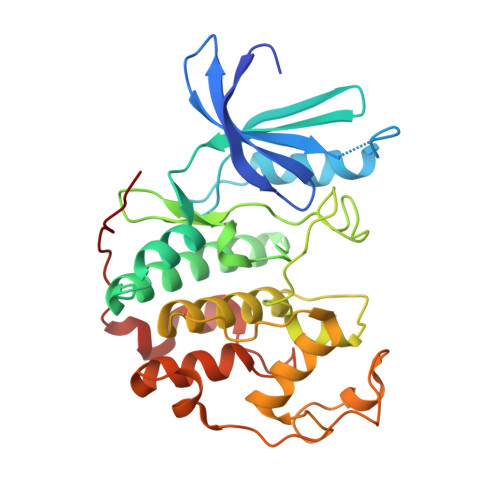Development of highly potent and selective diaminothiazole inhibitors of cyclin-dependent kinases.
Schonbrunn, E., Betzi, S., Alam, R., Martin, M.P., Becker, A., Han, H., Francis, R., Chakrasali, R., Jakkaraj, S., Kazi, A., Sebti, S.M., Cubitt, C.L., Gebhard, A.W., Hazlehurst, L.A., Tash, J.S., Georg, G.I.(2013) J Med Chem 56: 3768-3782
- PubMed: 23600925
- DOI: https://doi.org/10.1021/jm301234k
- Primary Citation of Related Structures:
3QQK, 3QTQ, 3QTR, 3QTS, 3QTU, 3QTW, 3QTX, 3QTZ, 3QU0, 3QXP, 3R8U, 3R8V, 3R8Z, 3R9D, 3R9H, 3R9N, 3R9O, 3RAH, 3RAK, 3RAL, 3RJC, 3RK5, 3RK7, 3RK9, 3RKB, 3RMF, 3RNI, 3RPR, 3RPV, 3RPY, 3RZB, 3S00, 3S0O, 3S1H, 3SQQ, 4GCJ - PubMed Abstract:
Cyclin-dependent kinases (CDKs) are serine/threonine protein kinases that act as key regulatory elements in cell cycle progression. We describe the development of highly potent diaminothiazole inhibitors of CDK2 (IC50 = 0.0009-0.0015 μM) from a single hit compound with weak inhibitory activity (IC50 = 15 μM), discovered by high-throughput screening. Structure-based design was performed using 35 cocrystal structures of CDK2 liganded with distinct analogues of the parent compound. The profiling of compound 51 against a panel of 339 kinases revealed high selectivity for CDKs, with preference for CDK2 and CDK5 over CDK9, CDK1, CDK4, and CDK6. Compound 51 inhibited the proliferation of 13 out of 15 cancer cell lines with IC50 values between 0.27 and 6.9 μM, which correlated with the complete suppression of retinoblastoma phosphorylation and the onset of apoptosis. Combined, the results demonstrate the potential of this new inhibitors series for further development into CDK-specific chemical probes or therapeutics.
- Drug Discovery Department, H. Lee Moffitt Cancer Center and Research Institute, 12902 Magnolia Drive, Tampa, Florida 33612, USA. ernst.schonbrunn@moffitt.org
Organizational Affiliation:

















